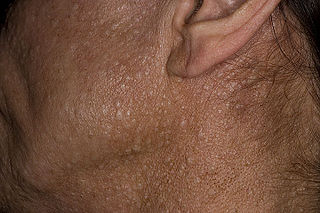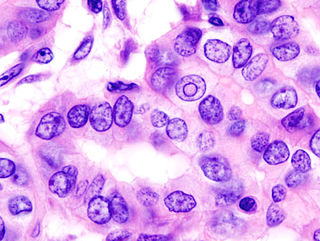Related Research Articles

Birt–Hogg–Dubé syndrome (BHD), also Hornstein–Birt–Hogg–Dubé syndrome, Hornstein–Knickenberg syndrome, and fibrofolliculomas with trichodiscomas and acrochordons is a human autosomal dominant genetic disorder that can cause susceptibility to kidney cancer, renal and pulmonary cysts, and noncancerous tumors of the hair follicles, called fibrofolliculomas. The symptoms seen in each family are unique, and can include any combination of the three symptoms. Fibrofolliculomas are the most common manifestation, found on the face and upper trunk in over 80% of people with BHD over the age of 40. Pulmonary cysts are equally common (84%), but only 24% of people with BHD eventually experience a collapsed lung. Kidney tumors, both cancerous and benign, occur in 14–34% of people with BHD; the associated kidney cancers are often rare hybrid tumors.

Langerhans cell histiocytosis (LCH) is an abnormal clonal proliferation of Langerhans cells, abnormal cells deriving from bone marrow and capable of migrating from skin to lymph nodes.

Targeted therapy or molecularly targeted therapy is one of the major modalities of medical treatment (pharmacotherapy) for cancer, others being hormonal therapy and cytotoxic chemotherapy. As a form of molecular medicine, targeted therapy blocks the growth of cancer cells by interfering with specific targeted molecules needed for carcinogenesis and tumor growth, rather than by simply interfering with all rapidly dividing cells. Because most agents for targeted therapy are biopharmaceuticals, the term biologic therapy is sometimes synonymous with targeted therapy when used in the context of cancer therapy. However, the modalities can be combined; antibody-drug conjugates combine biologic and cytotoxic mechanisms into one targeted therapy.

Anaplastic thyroid cancer (ATC), also known as anaplastic thyroid carcinoma, is an aggressive form of thyroid cancer characterized by uncontrolled growth of cells in the thyroid gland. This form of cancer generally carries a very poor prognosis due to its aggressive behavior and resistance to cancer treatments. The cells of anaplastic thyroid cancer are highly abnormal and usually no longer resemble the original thyroid cells and have poor differentiation.

Papillary thyroid cancer or papillary thyroid carcinoma is the most common type of thyroid cancer, representing 75 percent to 85 percent of all thyroid cancer cases. It occurs more frequently in women and presents in the 20–55 year age group. It is also the predominant cancer type in children with thyroid cancer, and in patients with thyroid cancer who have had previous radiation to the head and neck. It is often well-differentiated, slow-growing, and localized, although it can metastasize.

Erdheim–Chester disease (ECD) is an extremely rare disease characterized by the abnormal multiplication of a specific type of white blood cells called histiocytes, or tissue macrophages. It was declared a histiocytic neoplasm by the World Health Organization in 2016. Onset typically is in middle age, although younger patients have been documented. The disease involves an infiltration of lipid-laden macrophages, multinucleated giant cells, an inflammatory infiltrate of lymphocytes and histiocytes in the bone marrow, and a generalized sclerosis of the long bones.

The RETproto-oncogene encodes a receptor tyrosine kinase for members of the glial cell line-derived neurotrophic factor (GDNF) family of extracellular signalling molecules. RET loss of function mutations are associated with the development of Hirschsprung's disease, while gain of function mutations are associated with the development of various types of human cancer, including medullary thyroid carcinoma, multiple endocrine neoplasias type 2A and 2B, pheochromocytoma and parathyroid hyperplasia.

The sodium/iodide cotransporter, also known as the sodium/iodide symporter (NIS), is a protein that in humans is encoded by the SLC5A5 gene. It is a transmembrane glycoprotein with a molecular weight of 87 kDa and 13 transmembrane domains, which transports two sodium cations (Na+) for each iodide anion (I−) into the cell. NIS mediated uptake of iodide into follicular cells of the thyroid gland is the first step in the synthesis of thyroid hormone.

BRAF is a human gene that encodes a protein called B-Raf. The gene is also referred to as proto-oncogene B-Raf and v-Raf murine sarcoma viral oncogene homolog B, while the protein is more formally known as serine/threonine-protein kinase B-Raf.

BRCA1 associated protein-1 is a deubiquitinating enzyme that in humans is encoded by the BAP1 gene. BAP1 encodes an 80.4 kDa nuclear-localizing protein with a ubiquitin carboxy-terminal hydrolase (UCH) domain that gives BAP1 its deubiquitinase activity. Recent studies have shown that BAP1 and its fruit fly homolog, Calypso, are members of the polycomb-group proteins (PcG) of highly conserved transcriptional repressors required for long-term silencing of genes that regulate cell fate determination, stem cell pluripotency, and other developmental processes.

Thyroid cancer is cancer that develops from the tissues of the thyroid gland. It is a disease in which cells grow abnormally and have the potential to spread to other parts of the body. Symptoms can include swelling or a lump in the neck. Cancer can also occur in the thyroid after spread from other locations, in which case it is not classified as thyroid cancer.

Vemurafenib (INN), sold under the brand name Zelboraf, is a medication used for the treatment of late-stage melanoma. It is an inhibitor of the B-Raf enzyme and was developed by Plexxikon.
A MEK inhibitor is a chemical or drug that inhibits the mitogen-activated protein kinase kinase enzymes MEK1 and/or MEK2. They can be used to affect the MAPK/ERK pathway which is often overactive in some cancers.

Dabrafenib, sold under the brand name Tafinlar among others, is an anticancer medication for the treatment of cancers associated with a mutated version of the gene BRAF. Dabrafenib acts as an inhibitor of the associated enzyme B-Raf, which plays a role in the regulation of cell growth.

Binimetinib, also known as Mektovi and ARRY-162, is an anti-cancer small molecule that was developed by Array Biopharma to treat various cancers. Binimetinib is a selective inhibitor of MEK, a central kinase in the tumor-promoting MAPK pathway. Inappropriate activation of the pathway has been shown to occur in many cancers. In June 2018 it was approved by the FDA in combination with encorafenib for the treatment of patients with unresectable or metastatic BRAF V600E or V600K mutation-positive melanoma.
Noninvasive follicular thyroid neoplasm with papillary-like nuclear features (NIFTP) is an indolent thyroid tumor that was previously classified as an encapsulated follicular variant of papillary thyroid carcinoma, necessitating a new classification as it was recognized that encapsulated tumors without invasion have an indolent behavior, and may be over-treated if classified as a type of cancer.

BRAF-activated non-protein coding RNA is a noncoding RNA that in humans is encoded by the BANCR gene. Long non-coding RNAs (lncRNAs) are involved in the intricate network of cancer and contribute significantly to tumorigenesis and progression. BRAF activated non-coding RNA (BANCR), a 693-bp four-exon transcript, was first identified in 2012 as an oncogenic long non-coding RNA in BRAFV600E melanomas cells and was found to be associated with melanoma cell migration. Apart from melanoma, growing evidence has implicated BANCR in the development and progression of a variety of other human malignancies, including retinoblastoma, lung cancer, and gastric cancer, since its discovery. The pattern of expression of BANCR varies according to the kind of cancer, acting as either a tumour suppressor or an accelerator. Functional BANCR may be a useful biomarker for cancer diagnosis and prognosis assessment. BANCR-targeted therapy may also prove to be a promising new treatment option for human cancers.

Transmembrane protein 171 (TMEM171) is a protein that in humans is encoded by the TMEM171 gene.
RET inhibitors are targeted therapies that act on tumors with activating alterations in the RET proto-oncogene, such as point mutations or fusions. They fall under the category of the tyrosine kinase inhibitors, which work by inhibiting proteins involved in the abnormal growth of cancer cells. Existing molecules fall in two main categories: the older multikinase inhibitors and the more recent selective inhibitors. Although RET alterations are found at low frequency in a broad range of tumors, the three main indications for RET inhibitors today are non-small cell lung cancer, medullary thyroid cancer and papillary thyroid cancer. As of 2020, up to 48 fusion partners have been catalogued in NSCLC rearrangements, with KIF5B and CCDC6 being the most prevalent. At least 10 different fusion variants have been described for KIF5B-RET, each with different breakpoints within the partner gene, but unclear clinical impact as of 2018.
References
- ↑ Davies H, Bignell GR, Cox C, Stephens P, Edkins S, Clegg S, et al. (June 2002). "Mutations of the BRAF gene in human cancer" (PDF). Nature. 417 (6892): 949–54. doi:10.1038/nature00766. PMID 12068308. S2CID 3071547.
- ↑ Ritterhouse LL, Barletta JA (September 2015). "BRAF V600E mutation-specific antibody: A review". Seminars in Diagnostic Pathology. 32 (5): 400–8. doi:10.1053/j.semdp.2015.02.010. PMID 25744437.
- ↑ Maldonado JL, Fridlyand J, Patel H, Jain AN, Busam K, Kageshita T, et al. (December 2003). "Determinants of BRAF mutations in primary melanomas". Journal of the National Cancer Institute. 95 (24): 1878–90. doi: 10.1093/jnci/djg123 . PMID 14679157.
- ↑ Maverakis E, Cornelius LA, Bowen GM, Phan T, Patel FB, Fitzmaurice S, He Y, Burrall B, Duong C, Kloxin AM, Sultani H, Wilken R, Martinez SR, Patel F (May 2015). "Metastatic melanoma - a review of current and future treatment options". Acta Dermato-Venereologica. 95 (5): 516–24. doi: 10.2340/00015555-2035 . PMID 25520039.
- ↑ Tiacci E, Trifonov V, Schiavoni G, Holmes A, Kern W, Martelli MP, et al. (June 2011). "BRAF mutations in hairy-cell leukemia". The New England Journal of Medicine. 364 (24): 2305–15. doi:10.1056/NEJMoa1014209. PMC 3689585 . PMID 21663470.
- ↑ Dietrich S, Zenz T (December 2015). "BRAF inhibitor therapy in HCL". Best Practice & Research. Clinical Haematology. 28 (4): 246–52. doi:10.1016/j.beha.2015.10.001. PMID 26614903.
- ↑ Puxeddu E, Moretti S, Elisei R, Romei C, Pascucci R, Martinelli M, et al. (May 2004). "BRAF(V599E) mutation is the leading genetic event in adult sporadic papillary thyroid carcinomas". The Journal of Clinical Endocrinology and Metabolism. 89 (5): 2414–20. doi: 10.1210/jc.2003-031425 . PMID 15126572.
- ↑ Elisei R, Ugolini C, Viola D, Lupi C, Biagini A, Giannini R, Romei C, Miccoli P, Pinchera A, Basolo F (October 2008). "BRAF(V600E) mutation and outcome of patients with papillary thyroid carcinoma: a 15-year median follow-up study". The Journal of Clinical Endocrinology and Metabolism. 93 (10): 3943–9. doi: 10.1210/jc.2008-0607 . PMID 18682506.
- ↑ Li WQ, Kawakami K, Ruszkiewicz A, Bennett G, Moore J, Iacopetta B (January 2006). "BRAF mutations are associated with distinctive clinical, pathological and molecular features of colorectal cancer independently of microsatellite instability status". Molecular Cancer. 5: 2. doi:10.1186/1476-4598-5-2. PMC 1360090 . PMID 16403224.
- ↑ Sánchez-Torres JM, Viteri S, Molina MA, Rosell R (June 2013). "BRAF mutant non-small cell lung cancer and treatment with BRAF inhibitors". Translational Lung Cancer Research. 2 (3): 244–50. doi:10.3978/j.issn.2218-6751.2013.04.01. PMC 4367599 . PMID 25806238.
- ↑ Rothschild SI (May 2015). "Targeted Therapies in Non-Small Cell Lung Cancer-Beyond EGFR and ALK". Cancers. 7 (2): 930–49. doi: 10.3390/cancers7020816 . PMC 4491691 . PMID 26018876.
- ↑ Badalian-Very G, Vergilio JA, Degar BA, Rodriguez-Galindo C, Rollins BJ (January 2012). "Recent advances in the understanding of Langerhans cell histiocytosis". British Journal of Haematology. 156 (2): 163–72. doi: 10.1111/j.1365-2141.2011.08915.x . PMID 22017623.
- ↑ Kurppa KJ, Catón J, Morgan PR, Ristimäki A, Ruhin B, Kellokoski J, Elenius K, Heikinheimo K (April 2014). "High frequency of BRAF V600E mutations in ameloblastoma". The Journal of Pathology. 232 (5): 492–8. doi:10.1002/path.4317. PMC 4255689 . PMID 24374844.